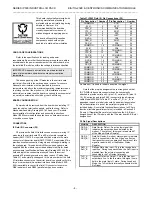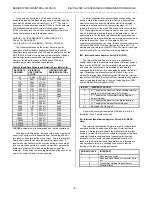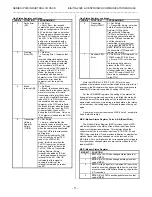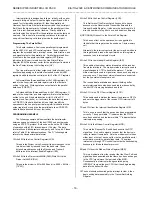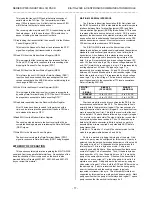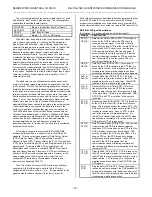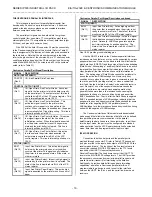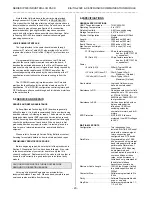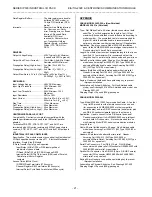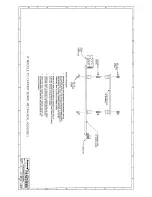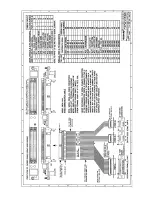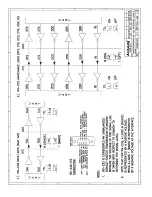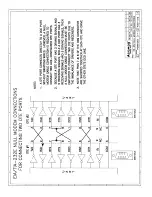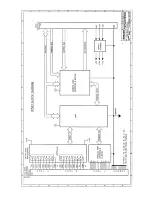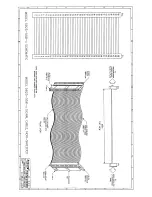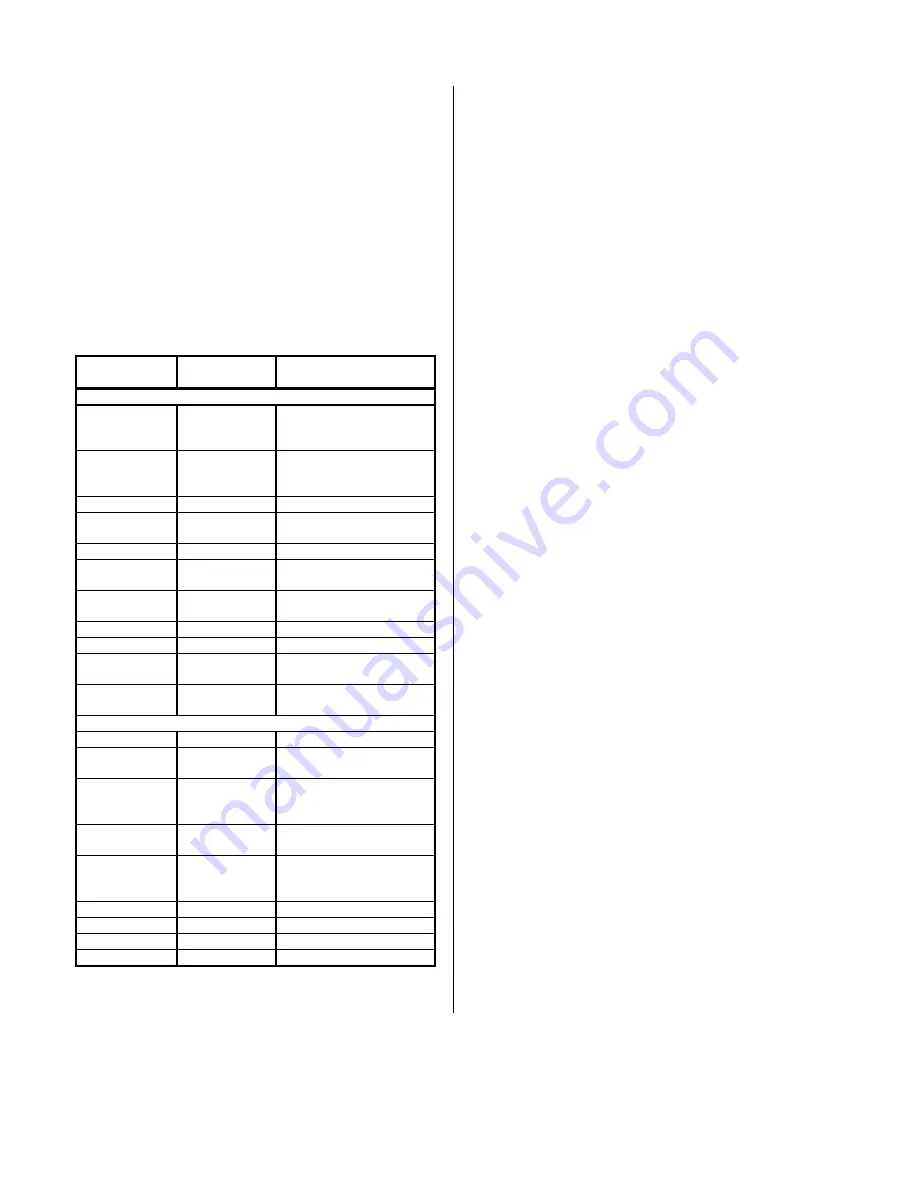
SERIES IP503 INDUSTRIAL I/O PACK EIA/TIA-232E & CENTRONICS COMMUNICATION MODULE
___________________________________________________________________________________________
- 14 -
THE EFFECT OF RESET
A software or hardware reset puts the serial channels into an
idle-mode until initialization (programming)A reset initializes the
receiver and transmitter clock counters. It also clears the Line
Status Register (LSR), except for the Transmitter Shift-Register
Empty (TEMT) and Transmit Holding-Register Empty (THRE) bits
which are set to 1 (note that when interrupts are subsequently
enabled, an interrupt will occur due to THRE being set)The
Modem Control Register (MCR) is also cleared. All of the
discrete signal lines, memory elements, and miscellaneous logic
associated with these register bits are cleared, deasserted, or
turned off. However, the Line Control Register (LCR), divisor
latches, receiver buffer register, and transmitter buffer register
are not affected. The following table summarizes the effect of a
reset on the various registers and internal/external signals:
REGISTER/
SIGNAL
RESET
CONTROL
STATE/ EFFECT
REGISTERS:
IER
Reset
All Bits low (Bits 0-3
forced low, Bits 4-7
permanently low)
IIR
Reset
Bit 0 high, Bits 1,2,3,6,7
low, Bits 4 & 5
permanently low
LCR
Reset
All bits low
MCR
Reset
All bits low (bits 5-7
permanently low)
FCR
Reset
All bits low
LSR
Reset
All bits low, except bits 5
& 6 are high
MSR
Reset
Bits 0-3 low, bits 4-7 per
corresponding input signal
LPC
Reset
All Bits low
LIV
Reset
All bits low
LEM
Reset
Bit 0 low (Bits 1-7 not
used)
LIM
Reset
Bit 0 high (PS-2 Mode)
(Bits 1-7 not used)
SIGNALS (INTERNAL & EXTERNAL):
TxD
Reset
High
Interrupt
(RCVR errors)
Read LSR/
Reset
Low
Interrupt
(RCVR data
ready)
Read RBR/
Reset
Low
Interrupt
(THRE)
Read IIR/Write
THR/Reset
Low
Interrupt
(Modem Status
Changes)
Read MSR/
Reset
Low
RTS*
Reset
High
DTR*
Reset
High
OUT1*
Reset
High
OUT2*
Reset
High
IP503 PROGRAMMING
Each serial channel of this module is programmed by the
control registers: LCR, IER, DLL, DLM, MCR, and FCR. These
control words define the character length, number of stop bits,
parity, baud rate, and modem interface. The control registers can
be written in any order, but the IER register should be written last
since it controls the interrupt enables. The contents of these
registers can be updated any time the serial channel is not
transmitting or receiving data
The complete status of each channel can be read by the host
CPU at any time during operation. Two registers are used to
report the status of a serial channel: the Line Status Register
(LSR) and the Modem Status Register (MSR)A third register, the
Line Printer Status Register (LPS), monitors the status of the
Centronics parallel port
Serial channel data is read from the Receiver Buffer Register
(RBR), and written to the Transmitter Holding Register
(THR)Writing data to the THR initiates the parallel-to-serial
transmitter shift register to the TxD line. Likewise, input data is
shifted from the RxD pin to the Receiver Buffer Register as it is
received. Parallel data is written to or read from the Line Printer
Data Register (LPT)
The Scratchpad/Interrupt Vector Register is used to store the
interrupt vector for the port In response to an interrupt select
cycle, the IP module will provide a read of this port register. As
such, each port may have a unique interrupt vector assigned.
Interrupts are served in a shifting-priority fashion as a function of
the last interrupting port serviced to prevent continuous interrupts
from a higher-priority interrupt channel from freezing out service
of a lower priority channel
This board operates in two different modes. In one mode,
this device remains software compatible with the industry
standard 16C450 family of UART’s and provides double-buffering
of data registers. In the FIFO mode (enabled via bit 0 of the FCR
register), data registers are FIFO-buffered so that read and write
operations can be performed while the UART is performing serial-
to-parallel and parallel-to-serial conversions
Two FIFO modes of operation are possible: FIFO Interrupt
Mode and FIFO Polled Mode. In FIFO Interrupt Mode, data
transfer is initiated by reaching a pre-determined trigger-level or
generating a time-out condition. In FIFO-Polled Mode, there is no
time-out condition indicated or trigger-level reached. The
transmit and the receive FIFO’s simply hold characters and the
Line Status Register must be read to determine the channel
status
Acromag provides an Industrial I/O Pack Software Library
diskette (Model IPSW-LIB-M03, MSDOS format) to simplify
communication with the board. Example software functions are
provided for both ISAbus (PC/AT) and VMEbus applicatIons. All
functions are written in the “C” programming language and can be
linked to your applicatIon. For more details, refer to the
“READMETXT” file in the root directory on the diskette and the
“INFO503TXT” file in the appropriate “IP503” subdirectory off of
“\VMEIP” or “\PCIP”, according to your carrier




